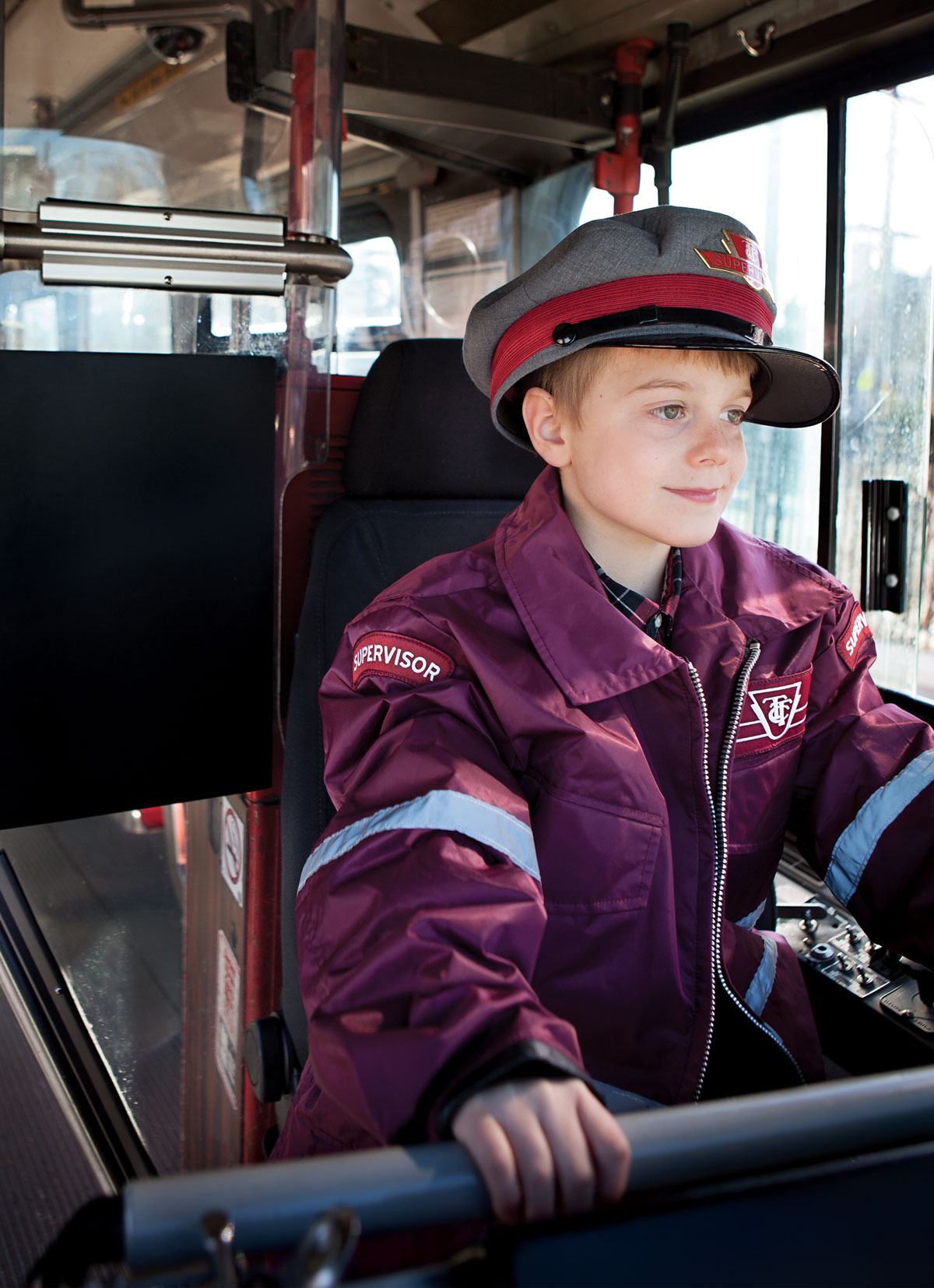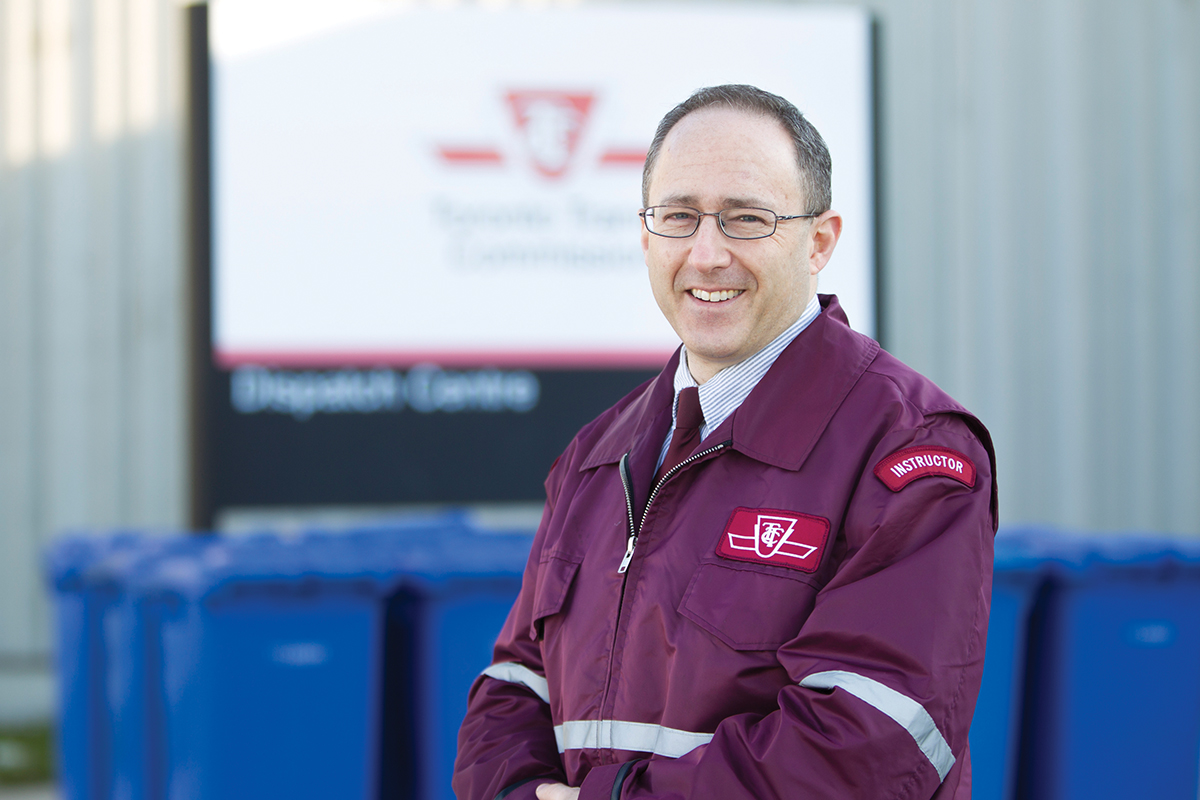
Most kids who play with toy trains lay their track in a circle. Cole Fleming lays his in the shape of a U—just like the track of his favourite subway line. Cole was only four years when he first became fascinated by the subway. That’s when his mother, Teresa, started taking him to music classes. To get there, Cole and his mother rode a bus that stopped near their house, which dropped them off right at the subway entrance. From there, they took an escalator underground, to where subway trains run deep beneath the city streets. Cole liked sitting in the front car and looking out the window as the train made its way down the tunnel. He became very interested in how buses and subways worked. Whenever he could, he’d ask the people who drove the bus and subway lots of questions, and remembered all the things they did to make their vehicles move. “I think pretty soon he became more interested in the ride than in going to music class!” says Cole’s mother.
Cole lives in Toronto, a city with three subway lines, about a dozen streetcar routes, and lots and lots of buses. Together, these subways, streetcars, and buses make up the Toronto Transit Commission, or T.T.C., the city’s public transportation system. Public transportation is an important way of helping people get where they need to go, and each type of vehicle plays a different role. By running underground, subway trains avoid traffic and can move people over long distances very fast. Streetcars are a little like subways trains: they move along tracks, but they’re not as long and they run on the road. Streetcars are less expensive to operate than subways, and can still carry a lot of passengers, so they’re most helpful in busy downtown areas. Buses don’t carry as many people, but because they don’t run on tracks, they can go places subways and streetcars don’t reach. They’re especially useful in areas where fewer people live. All three forms of public transportation help passengers move around without having to use a car, and fewer cars on the road means less pollution and less traffic. If everyone travelled where they needed to go in a car, there would be so many cars on the road that no one would get anywhere! That’s why public transportation is especially important in big cities.
As Cole got older, he remained curious about public transportation. When he was six, Cole became friends with Joel, a bus driver on the route near Cole’s house. Cole always sat at the front of Joel’s bus so he could see what buttons Joel pressed and what levers Joel pulled. Joel could tell Cole was very interested in how his bus worked, and he always answered Cole’s questions. He explained to Cole how he got his bus-driver’s licence, how long he had to practise to become a good bus driver, how to open the bus’s door, and how to lower the bus to make it easier for people to get on and off. One time, he even let Cole make an announcement over the bus’s loudspeaker. Cole wished the other passengers a good morning, welcomed them to Joel’s bus, and thanked them for using the T.T.C.
When Cole started school and was about to get his first report card, he asked his mother if anyone ever gave Joel a report card. Cole’s mother told him she didn’t think so. “So how would Joel know if he’s doing a good job?” Cole asked. So Cole and his mother decided to let the T.T.C. know what a great bus driver Joel was. With his mother’s help, Cole wrote an E-mail to Andy Byford, the man in charge of the Toronto Transit Commission. To Cole’s surprise, Mr. Byford wrote him back. He said he was happy to hear what a good job Joel did every day. In fact, Mr. Byford was so pleased to get Cole’s letter that he made sure it was read out loud at a meeting of other people who worked for the T.T.C. “It was exactly the kind of letter we want to see from our young riders,” says Mr. Byford.
Mr. Byford wrote that he could see Cole was a big fan of buses, and invited him to visit the Hillcrest Complex, a big garage where the T.T.C. repairs its buses and streetcars. At Hillcrest, Cole saw buses hoisted up high for maintenance. He saw big engines being taken apart so they could be repaired. He saw the upholstery shop, where seats get covered and fixed. He even got to visit the paint shop. But most exciting of all, Cole got to drive a bus simulator. A simulator is something people use to help them learn to do things like drive a bus or fly a plane. A simulator makes you feel like you’re really driving, while you’re actually safely seated indoors. People learning to drive in the T.T.C.’s simulator sit in the cab of a real bus that has been disassembled and fitted with video screens where the windshield and windows once were. The simulator has five screens in the front, and three more at the back that the driver will see when looking in his rear-view mirrors. These screens play a computer-animated street scene that reacts to everything the person in the driver’s seat does, from turning the wheel to opening the door. Thanks to Joel, Cole already knew a lot about how to operate a bus, and his instructor was very impressed. “He crashed the simulator twice,” laughs Cole’s mother, “but they did say that he caught on to it quicker than some of the trainees.”
Today, Cole is eight, and he still loves the T.T.C. Recently, Cole—accompanied by two adults—spent a whole Sunday exploring transit lines he’d never been on before. He rode a subway north, and then a subway east. Then he took a bus to Toronto’s “rapid transit” line: a train that looks like a small subway, but runs above ground like a streetcar, on an elevated track that keeps it out of traffic. Cole took the rapid transit train south and then west to where the train met another subway. He took that subway further west, before getting on a bus, and then another bus that took him back home. When Cole goes exploring, he wears a T.T.C. toque Joel the bus driver gave him as a present. Sometimes, like today, his toque earns him a honk from a subway driver. It was a long day, but where some kids would rather spend their Sunday playing video games, Cole is happy riding buses and subway trains. “It’s fun to figure out all the routes to get places,” Cole says. “Cars are boring.”
Last year, Cole and his parents visited Chicago. Cole made sure a part of their trip included taking a ride on that city’s subway system, which has even more lines and stops than Toronto’s. Cole’s mother is happy Cole has a hobby he enjoys. “He notices things, and he asks questions, and those questions lead to more questions,” she says. “He doesn’t just accept the first answer. He has an enquiring mind. He wants to know and he’s got an organized approach to finding out things.”
Mr. Byford thinks it’s important for kids who live in big cities to be familiar with their public transportation system. “Knowing about transit is a good thing because it enables you to get around safely and be able to navigate your way around the system independently when you’re older,” he says. “We really want people to respect their community and respect transit. If they learn how to do that when they’re young, they will be great citizens and riders of the future.”
Cole has a lot of years of school left to finish, and there are still a lot of new things for him to do and see. But so far, Cole thinks he’d like to grow up to drive subways and buses and streetcars himself. “I get inspired by them,” he says. “I really like it.” Mr. Byford says if Cole studies hard and keeps learning, someday, Cole might be able to get his wish. “I think Cole is probably one of our biggest fans, and a great little ambassador,” says Mr. Byford. “We’re hoping one day he’ll be a T.T.C. employee.”
Meet Joel the Bus Driver
Becoming a bus driver isn’t easy. Just ask Joel Pinsk. By the time Joel started working for the Toronto Transit Commission, in 2008, he already had years of experience driving lots of different vehicles, including motorcycles and race cars. But Joel still had to spend several weeks studying, doing homework, and writing tests before being allowed behind the big wheel of a bus.

Joel says it takes even more than studying and experience to be a successful bus driver: “If you’re able to deal with people who might be frustrated trying to get from Point A to Point B, and you’re able to stay calm and add a little humour in certain situations, those are the kinds of people the T.T.C. is looking for.”
After five years of driving a bus, Joel was promoted to a job supervising other bus drivers, and today he trains new employees on the T.T.C.’s bus simulator, among other things. Joel says teaching other people how to be safe drivers is the job he always dreamed of—that’s why he’s always happy to answer questions from curious passengers like Cole. “Cole knows a lot of stuff because he’s pretty inquisitive and pretty observant,” says Joel. “If you show a major interest in what you do, you’ll excel at it.” And if anyone is proof of that—it’s Joel!